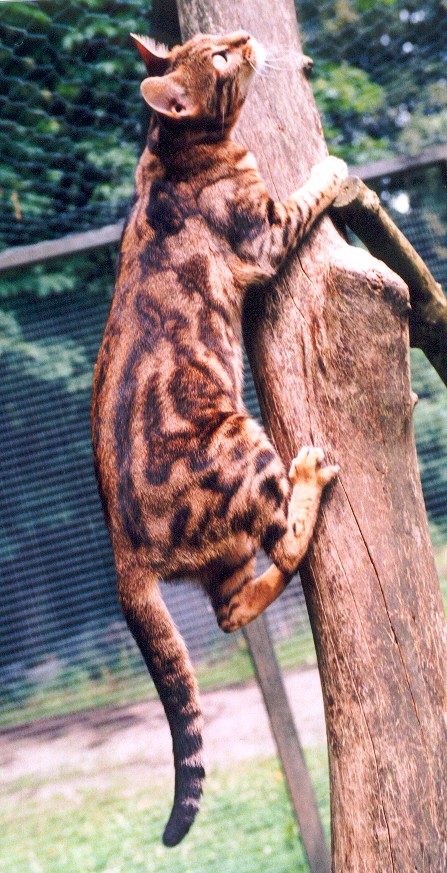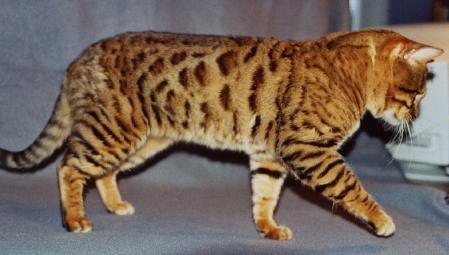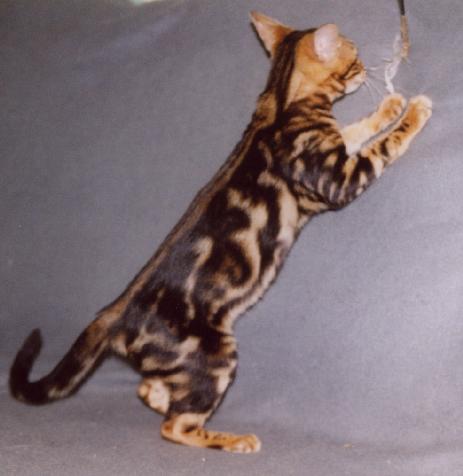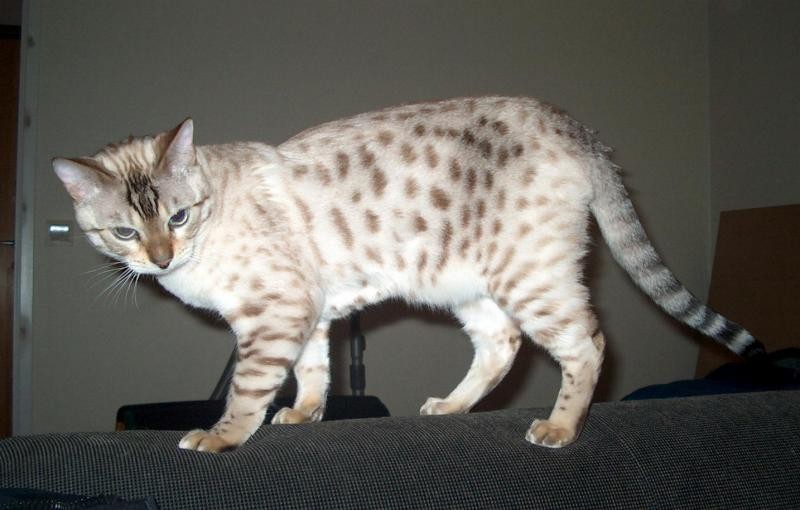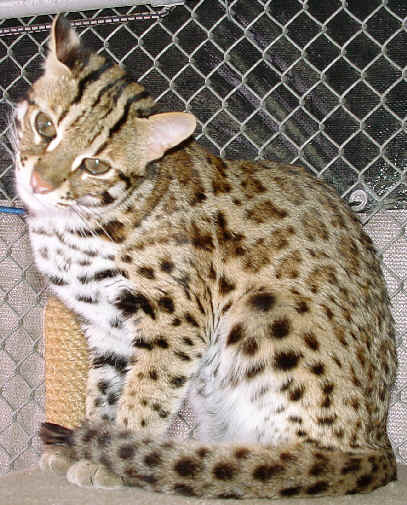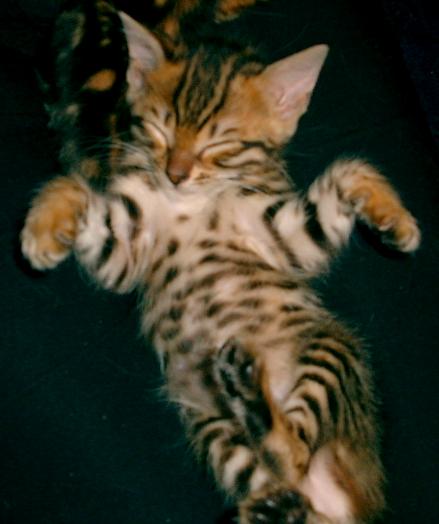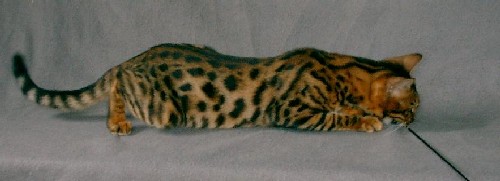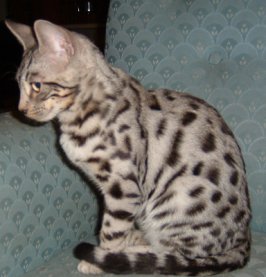Bengal – a Beautiful and Active catText and Photos: Anita H. Engebakken, Kimburu – Bengal & Sokoke
|
|
|
FIFe IC, TICA RW Spice Garlic of Kimburu Cat of the Year 2003 (NRR) |
The first thing people usually notice about the bengal is the colour and pattern. There are a lot more fascinating about the bengal that this. The bengal is an athletic, active and intelligent cat. It's also a person loving cat with a good temperament. The world of domestic cats has several spotted cat breeds to offer, some of these are; spotted Oriental shorthair, spotted British shorthair, Egyptian Mau and Ocicat. So what are the differences between those breeds and the bengal? The
Bengal are supposed to have a conformation that as much as possible
resembles the small forest dwelling wild cats The Bengals spots are on average bigger than most other spotted cats' spots, they should be arranged in a horizontal, diagonal or random order all over the body, including the legs and the tail. The marble pattern should be as different as possible from the normal classic tabby pattern with a horizontal or diagonal flow. The coats ground colour are often a lot clearer and generally much warmer toned on a bengal compared to other patterned cats. When you ad a few unique characteristics such as a very soft fur (called pelt) and glitter you get a coat that both looks and feels truly different and unique. Glitter is hollow tips at the end of the hairs making the cat look as if it was sprinkled with golden dust and the coat itself is "glittering".
|
|
Together the type, coat, pattern and personality makes the bengal a very different and unique breed of domestic cat
Glitter on Trollspotting Magneto's coat |
|
|
The pattern is what the bengal is "painted with", what you paint the pattern on, is the type. The type is at least as important to the correct appearance as the pattern and the colour. If you imagine the cat as solid black, you wouldn't know the difference between a bengal and a household pet if it wasn't for the type. The Bengal should have a relatively small head compared with many other cat breeds. The head is longer that it's wide. It should not look short, but neither as long as one of the oriental breeds. The contours of the head should be rounded. Nose should be wide, and the whisker pads pronounced. The cheek bones high and distinct. The eyes are big and oval. Ears should ideally be small, rounded and wide at the base. They should sit as much on top of the head as on the side of the head following the contours of the head itself. It is also very important for the correct expression to have a firm chin. In profile view the chins should be on the same vertical line as the upper jaw. The lower jaw should also have a certain thickness to it. The profile should have a long forehead and a very slight to almost straight concave curve of the nose. It is desired that the back skull extend behind the back of the ears. The
neck should be rather long and muscular. The muscular shoulders are very
distinct and give the impression of rolling when the bengal moves. The Bengals
has a rather long, muscular and powerful legs. The paws are big and round,
welcomed are also pronounced knuckles on the feet. The hind legs are
longer than the front legs. This enhances the impression of the rolling
shoulders making the cat prowl like the big cats on a hunt. Other Bengals
has a walk that looks like the smaller wild cats and yet other walks no
different than a house cat. The back is long and straight with the hind
quarters strong and muscular. The tail is thick and medium long and should
be carried low. This makes the back seem even longer. The total impression of a Bengal should be that of a medium to big athletic and muscular cat with a surprisingly long body. The Bengal should not look stocky, but like a combination of controlled strength and natural beauty and elegance.
Gaylee Kashmir, owned by Annette Lerche Trolle - Trollspotting
|
|
|
RW QGC Exoticrose Curry of Spice as a kitten
|
|
|
Pattern The legs shouldn't be stripy but spotted or blotched. The shoulder markings should be blotched on both the spotted and the marble pattern, a "dolphin" shape on the shoulder is highly wanted. In the rib area a lot of Bengals has a bar or stripe running vertically, this is NOT wanted, neither in the spotted nor in the marble variety - it is called a ribbar. A ribbar does not fit into the wanted horizontal or diagonal flow in the pattern. Something else that is highly unwanted is a bull's-eye. This is easiest seen with the marble variety, but the spotted variety could have the pattern running in a strong bull's-eye "flow" as well. Both the spotted and the marble is not to have any pure white spot anywhere on the body that isn't a part of the pattern itself (see above for the description of white areas). A white spot surrounded by other colours or breaking the pattern is called a locket and this is a direct fault in the colouring. The coat should generally be clear and not have gray tips of the hairs, these gray tips are called ticking and isn't wanted. Some very good cats with other characteristics worth breeding for could have a bit of ticking without this being a major problem.
|
|
|
RW SGC Joykatz Momentum of Spice |
Rosettes Some bengals have rosettes. These are simply said two coloured markings. They could be "made" to ways. Either by having a circle of spots with a center that is warmer/darker than the ground colour of the cat. Or by having a large spot opening up to get a lighter center, but the center is still darker/warmer in colour than the ground colour of the cat. Since rosettes are only found on the Bengal among the domestic breeds, because they're very beautiful and because the small forest dwelling wild cats have them, they are very much wanted. The most common form of rosettes are called shadow rosettes. They consist of a dark spot with a warmer "shadow" than the ground colour. Some Bengals has shadow rosettes almost all over they're body. Arrow headed rosettes are shaped as an arrow pointing backwards on the cat. The tip of the arrow is dark, and it's center is rosette coloured. The arrow headed rosettes are almost triangular in shape. |
|
Paw-print rosettes are dark spots encircling a warmer center. Paw prints are irregular in shape. Doughnut rosettes are almost circular or circular rosettes which have the dark marking, outlining, almost all around the rosette itself. These are the most spectacular rosettes. Often
you find that Bengals have rosettes on the sides, while the rear,
shoulders and back only have regular spots. The ideal is to have rosettes
all over, including down the tail. The
wish is of course for all Bengals to have this unique and beautiful trait
among domestic cats. It is steadily becoming more and more normal with
rosettes and the rosettes themselves become more and more spectacular.
There are still only a few Bengals that are truly rosetted all over big
rosettes, but the number is growing each year. Some breeders work very
hard to put the best possible rosettes onto their cats, and this
contribute to the benefit of every other breeder using these cats for
breeding. My guess is that within 5 years almost every Bengal will have at
least some really good rosettes. |
RW SGC Spice Cayenne |
|
CH Kimburu Zou JW, owned by enûma elîsch |
The
Marble Bengal
The Bengal comes in one more pattern than the most widely know brown spotted tabby. This pattern is pattern called marble. This is a pattern derived from the classic tabby, but should have a horizontal or diagonal flow, making it look distinctly different from the classic tabby and resembling the pattern of marble. The classic tabby "bull's-eye" is strongly unwanted in the marble pattern. Also the marble pattern could be "rosetted". The "rosettes" in the marble pattern shows itself by having lighter centers of the patterns that are warmer/darker than the ground colour. Rosetted marble Bengals are often called tricolour marble. Some marble Bengals show an amazing chain rosetting, others have a very chaotic pattern. Most marble Bengals today has some rosetting and a pattern that is more streched than a classic tabby pattern, but there is far between the really good marble Bengals, just as there is far between the really good spotted Bengals. Instead of spotted legs, the marble should have blotched legs, but not stripy. As with the Spotted Bengal a rosetted tail is wanted, but the bands on a marble tail is much broader than on a spotted tail. Like the spotted tabby white whisker pads, chin, chest, tummy and inner side of legs are wanted. And the tummy must be spotted. Colours are the same as for the spotted variant.
|
|
Smallville's Aleister, seal spottet lynx point Photo, breeder and owner: Øyvind Pettersborg, Smallville
|
Snow Bengals In addition to these brown Bengals, there are something called snow Bengals. There are three different kinds of Snow bengals, and all three are comes in both spotted and marble pattern. The most widespread snow variant, at least in Europe, is the seal lynx point. Lynx point is a colour coming the Siamese point gene. The Bengal is bred to have as little as possible "points", that means the difference in colour on the legs, head and tail compared to the bodies markings should be as little as possible, this is completely opposite of what they want for the Siamese. These snow Bengals have blue eyes, almost white ground colour and light brown to darker brown or more gray pattern colour. Most seal lynx Bengals are born completely white, but there are more and more born with a very pale pattern. The pattern will become more and more visible as the cat gets older, but the ground colour will darken some as well. Those seal lynx point Bengals with less rufism often get the best contrasts as adults, as the ground colour stay lightest on these cats. As kittens those with little rufism could be recognized by having grayish instead of warm brown colour on the back of their ears. |
|
The
other two snow variants are seal mink and seal sepia. Earlier one thought
it easy to see the difference between these two, but experience has show
this to be virtually impossible sometimes. Some seal minks are so
colourful and dark marked that they look like seal sepias, and some of the
lighter seal sepias look like seal minks. This is why I describe the two
as one. Seal sepia is a bengal with a "Burmese colour". It's "pointed" as a Burmese, but this variant as well should have as little as possible difference between the points and the body colour. A seal sepia snow bengal is normally far darker than a seal lynx point. Often ivory to light tan ground colour and a dark brown to almost black pattern. The eye colour is usually green or yellow. Seal mink is a mixture between the seal sepia and the seal lynx point. It looks like a seal sepia, or perhaps a little lighter in colour. The eye colour of a mink bengal could be aqua, but they often have green or even golden eye colour. Meaning you cannot differ between the sepia and the mink using eye colour. In reality you can't see the difference between the two variants seal sepia and seal mink. The only certain way to distinguish between the two is to know the genetic background, or prove it's genetic makeup by breeding. Most cats of unknown colour between these two are registered as minks. The Bengal is supposed to give the impression of a wild cat, how does the snow Bengals fit into this description? The seal lynx point could be argued to look like the white with pattern, blue eyed, Tigers, Servals and Lions that appear from time to time. The seal sepia and the seal mink Bengal could be argued to have a similar colour to that of the beautiful Snowleopard.
|
Foto: © Helmi RW SGC Bridlewood Knight in White Satin, seal spottet sepia Owners: Chris Jacobson, Speakeasy Bengals Nancy Robichaud, Provinmoutian Bengals
|
|
ALC Casanova of Exoticrose photo by Boris Ehret, Spice Bengals |
Origin The Bengal is a fairly new breed and it was created with the thought of making a cat breed looking like the small, exotic, spotted wild cats and with the temperament of the sweetest domestic cat. To achieve this goal they crossed a lot of different cat breeds and used a different cat species. The most important cat breeds were Egyptian Mau, Abyssinians and American Shorthairs. Some Burmese and Ocicat was used as well. In addition they used numerous housecats, some of these were imported form India. The other cat species they used was the small, shy and nocturnal (but not aggressive) Asian Leopardcat, Prionailurus bengalensis. Since the Bengal is such a new breed there are still created new lines of Bengals with Leopardcats. When the leopardcat is 4 generations back (is a great great grandfather), or further back, you have a SBT bengal. The Asian Leopardcats who were and are used for Bengal breeding is usually bred in different zoos, bottle-fed and socialized on humans and domestic cats. They could also be from private breeders specialized in breeding small exotic wild cats. All cats in the Bengal breeding program are to have proper paper and and those who own the cats must have a permit and competence to take care of them. From time to time there are used a wild caught Leopardcat, but those who use such cats I, Kimburu, chose not to work with. The first 3 generations after a leopardcat are called "foundation Bengals" or "early generation Bengals". The F-cats are somewhat different to keep than the ordinarily bengal (4th generation and later), but they get gradually more like a late generation bengal as you progress down the generations. A foundation Bengal is not a cat for everyone. They could be the most appreciated, wonderful cat to a few special people, but most people would appreciate a late generation, "real" , Bengal far more. |
|
Notice these handsome looking ALC's forehead markings, the white around his eyes, how rounded the ears are, how big the eyes are and their colour. How wide the nose is and how strong the chin is. Also notice the completely spotted legs and tail, the blotched shoulder markings, and the incredibly pure white tummy. All these are traits we want on our Bengals. |
|
PersonalityKey words describing the bengal as a breed are; 'active', 'curious', 'intelligent' and 'loving', in addition to it's beautiful looks. Bengals could play for hours, and when their energy level has calmed down, they'll gladly be cuddled. As most cats, Bengals loves to sit onto your newspaper, particularly the article you're reading at that very moment. They also like to discover what's under the paper and your blanket, the inside of our bag and boxes. Bengals are often drawn to water. Some Bengals end up taking showers with their owner, and some likes to play in the bathtub filled with some water. A big water bowl will do as well, but before drinking you have to splash around a little. Of course, all bengals don't like water. Some act just like any domestic cat when it comes to water. As everything else in the world of cats, you have to breed for cats who love water to make this characteristic be as pronounced as possible. Bengals are sometimes quite talkative cats. Usually they don't talk very loud, but if they want to almost every bengal could come with some very high and powerful sounds exceeding everything you expect from a small cat. Females in heat and fertile males are usually the most vocal.
|
Kimburu ZeZa, 9 weeks old |
|
Even if Bengals are very active cat, it's completely satisfied living a life indoors. A safe outdoor run is welcome if you have the possibility. If you are to keep the Bengal strictly indoors it should have the possibility of run and climb. Steps are often popular to let out energy, so are cat flaps. In a wild chase around the apartment/house Bengals could of course knock over things, but they aren't deliberately destructive. This goes for all active cats by the way. The activity level of a Bengal is also part of why it's so playful throughout most of it's life. Most Bengals love to play. What the favorite game is varies, but usually the traditional, simple cat toys are the best, like balls, play mice, "mouse on a tread", a "flying feather" and such.
Kimburu Zakros, 6 months old Because of their intelligence and activity level lots of Bengals are quite easily trained to do simple tricks. They think it's fun to do something together with their human. To teach a Bengal ticks are also a good way of stimulating the cats psyche as well as letting out some energy and it helps to bond with the cat as well. Ticks Bengals often learn by themselves or with the help of their human is to fetch toys, sit on their bottoms with forelegs up, jump to a nice "petting height" on command. Open drawers, lockers and doors are often quickly learned. Other tricks possible to teach cats if you have some patient is to jump, balance and walk through things, sit nicely and give pay and many other tricks. It's usually just the fantasy that stops what it's possible to learn an active and intelligent cat as the Bengal, as long as it isn't to extreme that is. Bengals need quite a bit of activating. A Bengal is only half a Bengal, they are best kept in company of another active cat. This doesn't apply for absolutely all Bengals, as some want to be "lonely cats". But company they want anyway. Bengals often appreciate company of other animals such as dogs in addition to humans. Most Bengals are a bit "dog like" themselves. They follow you all around the house and wants to be a part of everything that's happening. Of course there are differences in how active Bengals are. Some are close to "hyper active", while others are on a more normal level for an active cat (such as Ocicats, Siamese, Burmese etc).
|
|
Not recognized coloursBengals show up from time to time in colour variants not approved by the standard.Blue: The variant most often showing up, here in Europe at least, is blue Bengals. Blue Bengals have gray-blue pattern and a lighter gray-beige ground colour. They are very nice cats, but this variant is not recognized for getting certificats or points in the show ring, at least not in TICA and FIFe. Melanistic: Another variant showing up from time to time is solid black Bengals, often called melanistic, that means they don't have a pattern but is completely black. Some show blacker markings on a black ground colour, but these markings are very faint compared to that of the tabby bengal. Some breeders work on the acceptance of black bengals. Black is a "colour of the jungle" as there exist black wild cats, i.e. black leopards, black servals and black jaguars. NOTE: Black Bengals are NOT Pantherettes. To read more about the Pantherette, click here Other colours: Chocolate coloured Bengals show up sometimes as well. This means that Bengals carry both the dilution gene (d), the solid gene (a) and the chocolate gene (b). If you are really unfortunate you could risk to get a solid coloured lilac Bengal (aa bb dd), (luckily) I haven't heard of any such Bengal being born. All these colours, blue, solid black and chocolate is recessive to the brown tabby Bengal. |
|
|
Silver: A last variant of Bengal colour that are not recognized, is silver. Since silver is dominant, you have to have at least one silver parent to get silver kittens. You don't get a silver kitten just popping up, unless the parent(s) are wrongly registered. More and more Bengal breeders start to work with silvers and are having a silver breeding program. This is a rather popular colour and those who breed silver bengals work for their approval to be recognized side by side with the brown tabby and snow Bengals. A silver is silvery gray with black markings. To get the new line of silver Bengals there has been recent outcrossings to silver American Shorthairs. These cats have a very clear silver and good contrasts. Many breeders will argue that the silver Bengals look more like a snow leopard than the snow Bengals. From 1st May 2004 Silvers are recognized in TICA with CH status |
silver Bengal. Photo in courtesy of Deb Zorno, |
|
|
MythsLast I want to address a couple of myths about the Bengal The myth that I most often hear, and that seem to be the hardest to "kill off", is that the Bengal is an aggressive cat. This is NOT correct. The Bengal is a loving, tolerant and devoted cat. Of course thre are some individuals with a poorer temperament than you could wish for in this breed as in every other breed, but the Bengal as a breed is not aggressive. Many Bengals are on the other hand capable of producing some sounds that closely resembles that of an angry cat, without being angry. This might frighten people who doesn't know the cat, but it doesn't make it aggressive. The Bengal and it's personality probably have to be better know as what it is before this myth disappears completely. As with other breeds, a Bengal on a cat show behaves differently that at home. Some individuals don't like the show environment at isn't behaving very well because their uncomfortable. This is cats that should stay home for the consideration of the cat itself. These cats exist in all breeds of cats. The reason why you perhaps more often see bengals of this kind is because the breed is pretty small in Europe and a much higher number of the Bengals that exist are shown compared to the more popular breeds such as Persians, Siamese, Abyssinians, Norwegian Forest cats and other old, well established breeds. Another myth is about the Bengals size. This is NOT a cat at the size of a Northern Lynx, Leopard or any other big cat species. This is a domestic cat bred of medium to big size. |
|
It's about the same size as a Russian Blue or the Sokoke. It's a bit bigger than most Abyssinians and Burmese. Males often weigh from 4 to 6 kg and females are somewhat smaller. There exist bigger Bengals as well, but these are the exceptions not the rule. Bengals doesn't smell stronger or different than other domestic cats. It's nothing about the Bengals urine that make other cats go bananas. Of course two fertile males, no matter what breed, could get worked up by the smell of each other if they sit to close on a cat show. But this only normal. It varies how much a Bengals urine smells as well, but it is within the normal range for all domestic cats. The last issue I want to address is a question that often pop up. How much does a Bengal cost? This of course depends on what "quality" and rights you want with the cat. If you want a top show cat to be used for breeding, then you'll have to prepare yourself to pay far more than you do for a pet only that aren't to be shown or bred from. The Bengal is more expensive than most other pedigree cats here in Northern Europe at least, but there are other breeds on the same price level. |
|


